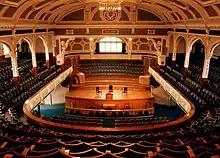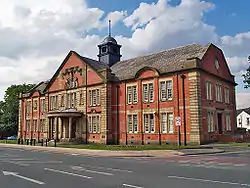Bradshaw Gass & Hope
Bradshaw Gass & Hope is an English architectural practice founded in 1862 by Jonas James Bradshaw (c. 1837–1912). It is Bolton's oldest architectural practice and has exhibited archive drawings in London and Manchester.[1] The style "Bradshaw Gass & Hope" was adopted after Bradshaw’s death to incorporate the names of the remaining partners, John Bradshaw Gass and Arthur John Hope.[1] As of 2022, the firm continues to operate from offices in Bolton.[2]

History
Jonas James Bradshaw first opened an office on Nelson Square, Bolton in 1862, then moved to 19 Silverwell Street in 1871. His nephew John Bradshaw Gass joined him in 1882 and Arthur John Hope was articled to the firm in 1892, becoming a partner in 1902.[3] [1]

Although Bradshaw was capable of designing fine Gothic Revival houses, like Watermillock (1880–1886), he mainly produced industrial buildings. The technical challenges of early iron and concrete framed factories led Bradshaw to employ structural engineers and quantity surveyors and he thus founded one of the first multidisciplinary practices. The emphasis on engineering in the practice benefited John Parkinson, Bradshaw's apprentice from 1877 to 1882, who later designed high-rise buildings including Los Angeles City Hall.[1]
From 1902 until 1912, the practice included a comma in its name.[1]
In the early 20th century, Bradshaw Gass & Hope achieved national prominence, winning several architectural competitions and commissions to build seven town halls between 1928 and 1939. During the period, Bradshaw Gass & Hope attracted many architecture students, several of whom went on to head council architects departments.[4]
Until the 1960s most of the firm's work was in the Classical idiom.[1]
Sir George Grenfell-Baines, the founder of Building Design Partnership, worked for the practice from 1930 to 1934 He was impressed by its multidisciplinary nature but dismayed by the then strictly hierarchical structure.[5]
Work
The firm's work includes:[6][7][8][1]
Jonas James Bradshaw with Leigh Hall
- Eaves Lane Workhouse, now hospital, Chorley (1869–1872)
J J Bradshaw
Bradshaw & Gass

- Mather Lane Mill, Leigh (1882)[9]
- Rutland Mills, Adelaide Street, Bolton (1883–1920)
- Lincoln Mill, Washington Street, Bolton (1883–1920)
- Bolton Evening News offices (1890–1907)
- Victoria Hall, Bolton (1898–1900)
- College of Art, Hilden Street, Bolton (1901–1903)
- Leysian Mission, now Imperial Hall, City Road (1901–1906)
- Grand Central Hall, Liverpool (1905)
Bradshaw, Gass & Hope


- Leysian Wesleyan Mission, Finsbury (1902–1904)
- Westhoughton Town Hall (1903–1904)
- Manchester Stock Exchange (1904–1906)
- Carnegie Library, Atherton (1904–1905)
- Baptist Church, Market Street, Farnworth (1906)
- Tollard Royal Hotel, Southampton Row (1907)
- Queen's Hall Methodist Mission, Market Street, Wigan (1907–1908)
- Croal Mill, Callis Road, Bolton (1908)
- Astley Bridge Carnegie Branch Library (1909–1912)
- Farnworth Town Hall and Carnegie Library (1909–1911)
- Great Lever Branch Carnegie Library (1909–1912)
- Stockport Central Carnegie Library (1912–1913)
- Leigh Spinners (1913)[10]
Bradshaw Gass & Hope



- Miners Hall, Bolton (1913–1914)
- Royal Exchange, Manchester (1914–1921)
- Workshops for the Blind, Marsden Road, Bolton (1914)
- Methodist College, Medak (1917–1925)
- Astley Bridge Mill, (1920–1927)
- Miners' Convalescent Home, Blackpool (1925–1927)
- UMIST, Manchester (1927–1957)
- War Memorial, Bolton (1928)
- Co-Op, Victoria Square, Bolton (1928)
- Lewisham Town Hall (1928–1932)
- Leith Theatre and Library (1929–1931)
- Bolton Town Hall extensions and Civic Centre (1930–1939)[11][12]
- Wimbledon Town Hall (1931)
- Trafford Town Hall (1932–1933)
- Boothstown Mines Rescue Station (1933)
- Luton Town Hall (1934–1938)
- Chesterfield Town Hall (1937–1938)
- Padiham Town Hall (1938)
- Turton High School, Bromley Cross (1939–1953)
- Completion of Bolton School (1945–1965)
- Police Station and Magistrates Court, Burnley (1951–1955)
- Police Headquarters, Salford (1958)
- Methodist Chapel, Halliwell (1959)
- ICI-Alkali Division Headquarters, Winnington, Northwich (1959–1960)
- Girls School, Broughton (1962)
- Municipal Offices, Newcastle-under-Lyme (1963)
- Offices for Jeyes, Thetford (1970)
- Bolton Arena (1999–2001)
Alumni
Partners
- John Jonas Bradshaw (c. 1837–1912)
- John Bradshaw Gass (1855–1939)
- Arthur John Hope (1875–1969)
- James Robert Adamson (1883–1943)
- Robert Mackison McNaught (1898–1969)
Others
- John Parkinson (1861–1935), architect
- Sir George Grenfell-Baines (1908–2003), founder of Building Design Partnership
References
- Lingard, Jane; Lingard, Timothy (2007). Bradshaw Gass & Hope – The Story of an Architectural Practice. London: Gallery Lingard. ISBN 978-0-9556035-0-1.
- "Bradshaw Gass & Hope". Bradshaw Gass & Hope. Archived from the original on 24 July 2010. Retrieved 5 December 2022.
- Bradshaw, Gass and Hope of Bolton, Architects, The National Archives, archived from the original on 9 November 2014, retrieved 9 November 2014
- Redman, Austen (2007). Clare Hartwell & Terry Wyke (ed.). Bolton Civic Centre and the Classical Revival Style of Bradshaw Gass & Hope. ISBN 978-0-900942-01-3.
{{cite book}}:|work=ignored (help) - George Grenfell-Baines (2000), interviewed by Louise Brodie at Preston, (January 5–11) Architects' Lives, London: National Biographical Archive, C467/46/F7839.
- A. Stuart Gray (1985) Edwardian Architecture: a Biographical Dictionary, ISBN 0-7156-2141-6.
- Nikolaus Pevsner (1969), Lancashire 1: the Industrial and Commercial South, The Buildings of England, ISBN 0-14-071036-1.
- Nikolaus Pevsner (1969), Lancashire 2: The Rural North, The Buildings of England, ISBN 0-300-09617-8.
- Historic England, "Mather Lane Mill (1356246)", National Heritage List for England, retrieved 9 November 2014
- Historic England, "Leigh Mill (1253119)", National Heritage List for England, retrieved 9 November 2014
- Historic England, "Town Hall (1388295)", National Heritage List for England, retrieved 9 November 2014
- Historic England, "Civic Centre (1352691)", National Heritage List for England, retrieved 9 November 2014
External links
- Bradshaw Gass & Hope Official site
